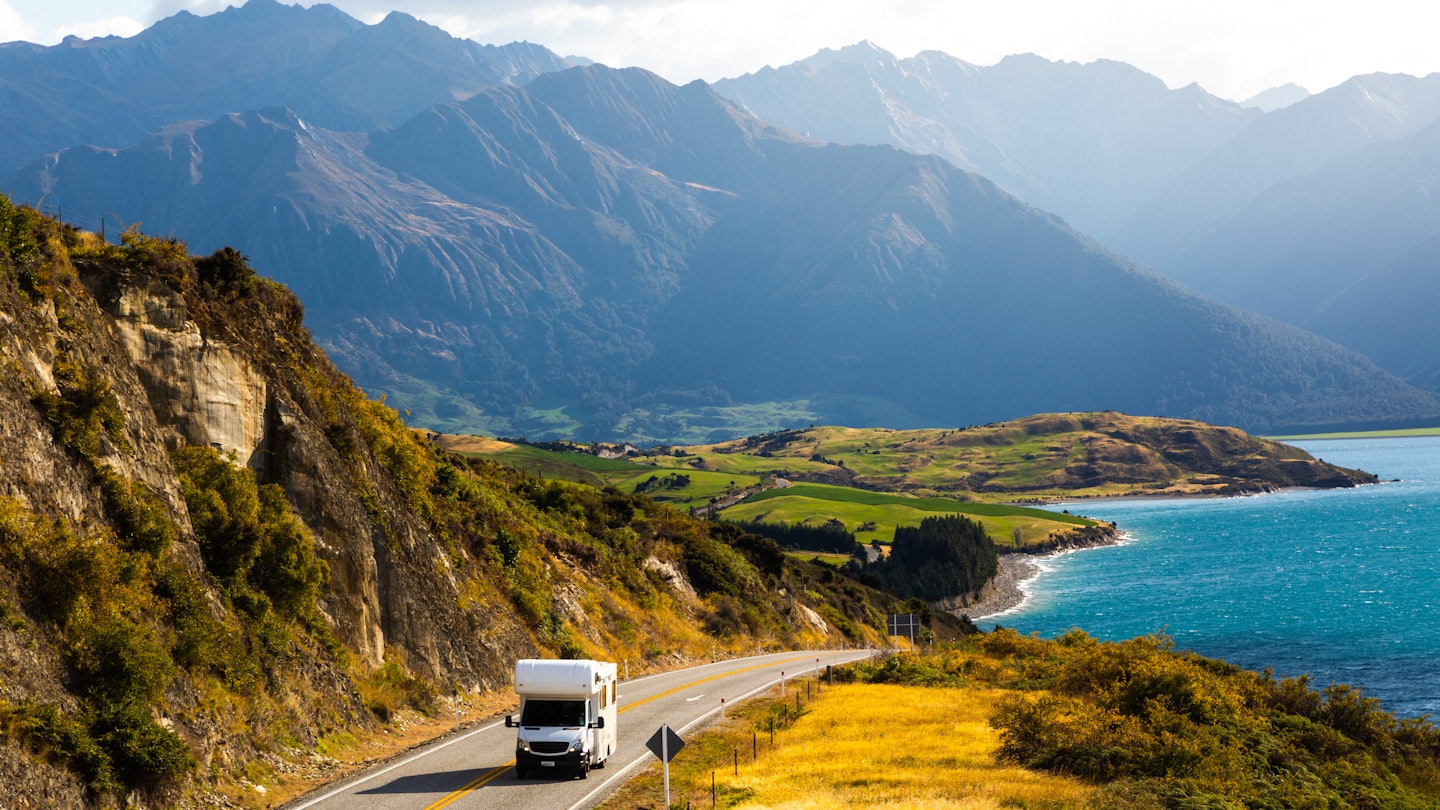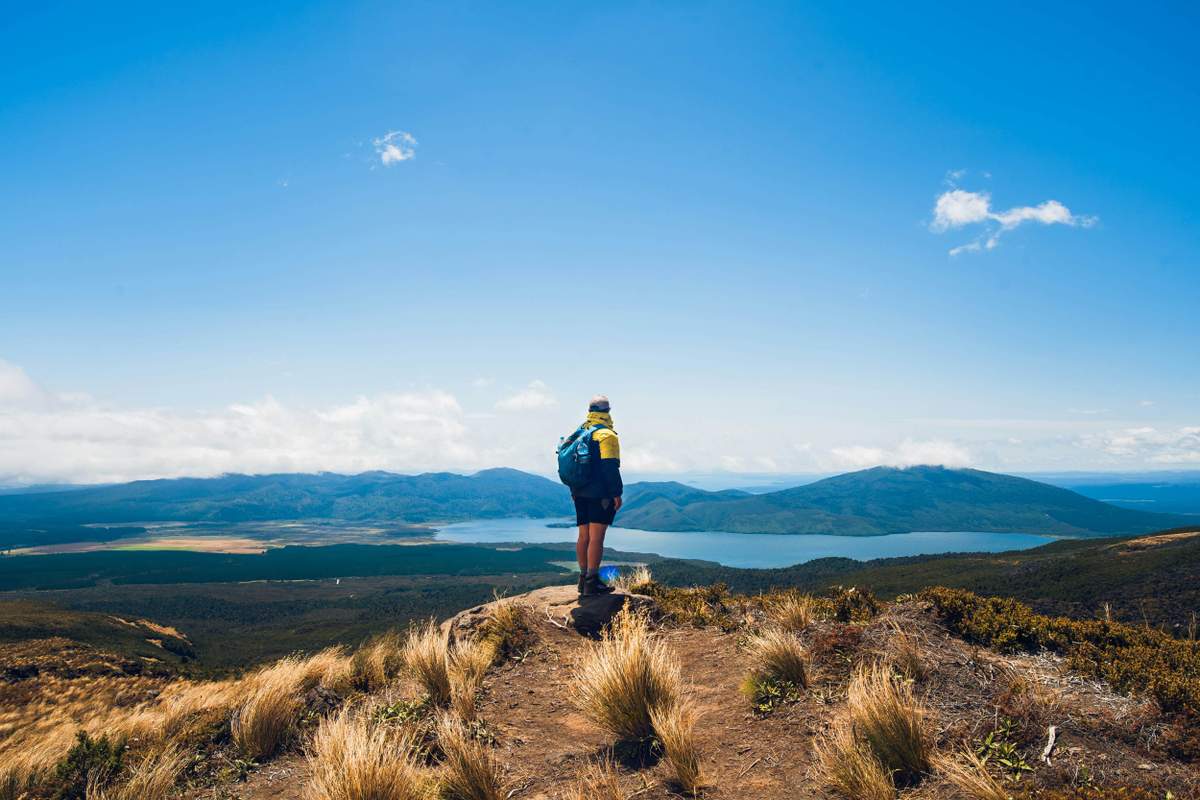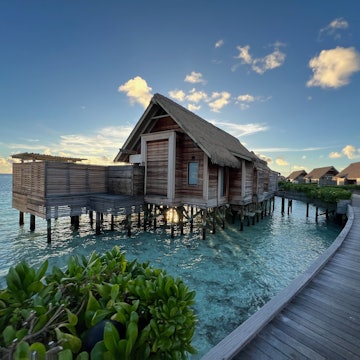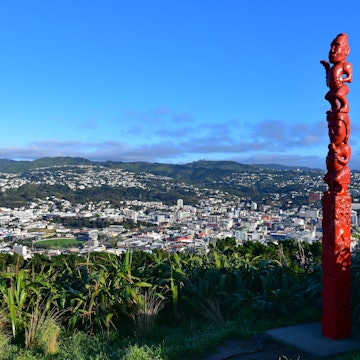

Lake Hāwea. Getty Images
Campervanning has always been a popular way to get around New Zealand, especially for travelers on a budget. This is in part thanks to the popularity of “freedom camping,” a system that allows parking overnight in designated areas at no cost. But it does come with some caveats.
Traveling the considerable length of Aotearoa (New Zealand’s Māori language name) in my own van, I have spent many nights in free camping spots. Some are right by the ocean; others high in the mountains. Even staying in urban free camping sites feels like an adventure, and it leaves you with more money to spend on incredible activities and getting to more amazing places in New Zealand.
It’s relatively easy to rent a van from one of the many providers when you arrive and get a taste of this lifestyle on a shorter trip. However, fuel and rental costs, along with changes to freedom camping laws, mean it’s no longer the super budget-friendly mode of transportation it once was.
Here’s how to plan a campervan trip in New Zealand right now.

Comparing the costs: renting a campervan versus renting a car
Trying out van life in New Zealand used to be about flexibility and a low cost way to travel. More recently, it has morphed into a lifestyle that comes with a price tag. If you’re traveling in the peak summer season from late December to late February, a campervan rental can run from 200 New Zealand dollars (NZ$) a day for a budget camper to more than NZ$500 a day for a motor home (RV).
Major companies for larger, self-contained motor homes include Maui, Britz and Wilderness; while Jucy, Spaceships and Big Little Campers offer more compact versions – either fully self-contained or non-self-contained – that are ideal for budget travelers. (Note the term "self-contained." I'll explain more later.)
Additional costs can come with a campervan. Diesel vehicles are cheaper to fill up (from around NZ$1.75 per liter), but you’ll be asked to pay the Road User Charges (RUCs). These charges are based on a government fee that's passed on to you by the rental company. On return, expect to pay an extra NZ$8 or so per 100km depending on the size of your vehicle.
With a gas-powered vehicle you avoid the RUCs, but you can expect to pay a lot at the fuel pump to fill up. Powering a campervan over New Zealand’s hilly landscapes takes more gas than a smaller, more nimble car, and gas costs upward of NZ$2.50 per liter.
Pro tip: Use the Gaspy app to find the best prices on fuel near you.

Should I rent a car instead?
A rental car, which can cost just NZ$80 a day in peak season, can work out to be almost as cost-effective if you stay in cabins or hotels, or BYO tent and pitch up each night. (The exception may be in larger cities like Wellington and Auckland, where hotel rooms in central areas come at a premium and overnight parking costs around NZ$50 per night.)
However, there are some ways that campervans come out on top. By porting your own kitchen around, you can make more of your own meals and save on the cost of eating out for breakfast, lunch and dinner. And car travel also means sacrificing some flexibility, as you’ll need to book accommodations in advance, especially over busy peak periods.
With a campervan, the trip is the experience. Once you’ve parked in one of New Zealand’s many stunning locations with easy access to hiking trails, beaches, sunsets and night skies, there’s really no need to do anything else.
Pro tip: Rental car and campervan relocation is an affordable option for budget-conscious travelers. These deals come up when a rental company needs to move vehicles from one location to another. Check Transfercar for free or discounted one-way rentals.
What about buying a campervan?
If you’re planning to stay for a few months or longer, you might consider buying a used van instead. Campervans change hands regularly between travelers. But don't forget to factor in the additional costs of insurance, registration and maintenance, which can be in the thousands of dollars for vehicles that have typically seen high mileage and many years on the road.

Can you park a campervan anywhere in New Zealand?
While freedom camping once meant being able to park at designated spots for free, now only motor home vehicles with plumbed-in toilets are classified as fully self-contained in New Zealand. To legally freedom camp, a self-contained vehicle is the minimum expected standard. Smaller campervans usually don’t meet the requirements, since they typically have portable camping toilets on board.
Vehicles must qualify for a self-contained Green Warrant Card, which requires a fixed onboard toilet, systems to load fresh water and dispose of wastewater (known as black water), a ventilation system, and secure trash storage.
This means you will need to buy or rent a larger (and more expensive) motor home if you want the flexibility of freedom camping in most places. If you’re caught camping in breach of the laws, penalties start at NZ$400, and it's NZ$200 even if you have a warrant card but it isn't displayed.
If you do plan on freedom camping, keep your expectations in check. Spots are often little more than parking lots where you’re allowed to stop overnight and need to vacate by the next morning. (I have spent the night in a parking lot next to the railway tracks in Dunedin and in empty fields with no view or facilities to speak of.)
Some freedom camping spots can be stunning though. One of my favorites is the Te Kopahou visitors center lot in Wellington. It’s only a 15-minute drive from the center of the city but right on the edge of the wild and windswept coast. Another is Castle Point in the Wairarapa region, next to a remote lagoon and a rocky outcrop with a lighthouse atop it. The more popular freedom camp spots fill up early, so you need to arrive earlier in the afternoon – there’s no way to reserve a spot.
How can I find affordable camping in New Zealand?
The easiest way to find campgrounds is through apps like Rankers Camping NZ and Campermate. In both apps, you can filter for free sites, locations that handle both self-contained and non-self-contained vehicles, and tent camping.
The Department of Conservation (DOC) has a nationwide network of more than 300 campgrounds, including around 90 that are free of charge. And because most have toilets, they can be used by non-self-contained vehicles. Many others cost from NZ$10–20 per night for a standard campsite (for either a campervan or a tent), which usually offers a water supply and a long-drop toilet (outhouse). Many DOC campgrounds can be booked online ahead of time, saving you from having to juggle cash at the campground itself.
For upgraded amenities, check out New Zealand’s holiday parks. With everything from hot showers and laundry to playgrounds and pools, these well-equipped campgrounds provide consistently good facilities, often in prime locations. Established holiday park chains include Tasman Holiday Parks and Top 10 Holiday Parks, with the latter offering memberships that gives you discounts on stays.
Another option for low-cost camping in a certified self-contained campervan or motor home is Okay2stay. The membership-based program (you can join for NZ$50) has more than 100 locations around the country where you can park for free for a night, if you support the hosts by buying their wine, produce or other artisanal goods. Hosts include boutique vineyards, craft breweries, orchards and dairy farms, so it’s a great way to get to know local growers and producers – and keep your kitchen well stocked.
How much time do I need for a campervan trip around New Zealand?
Road-tripping around New Zealand takes a lot longer than you probably think. The country is roughly the size of Italy, with a population of just over 5 million, which means everything is very spread out, especially on the South Island. Roads are often narrow and winding, and you’ll probably want to factor in time to stop to look at the scenery.
Larger motor homes are restricted to 90km/h, even when the general speed limit is 100km, but you’ll struggle to get going that fast in this hilly terrain.
The minimum amount of time for a campervan trip in New Zealand is 1–2 weeks focused on one island. Many campervan rental companies offer pickups and drop-offs in Auckland and Christchurch, with a handful also servicing Queenstown and other smaller towns. This makes Auckland and Christchurch the main start and end points by default.
If you have 3 weeks or more, you could start from Auckland and head south, covering both islands. Just remember that if you plan on traveling between New Zealand's islands, book your ferry ticket in advance, as spots can sell out over the busy season. Also check if your rental vehicle can be moved between islands.

The environmental impact of campervan travel
In a lot of areas, campervans put pressure on the environment. Although most van travelers do it for the love of nature, the lack of proper facilities in freedom camping areas can result in waste being left behind, which is what triggered New Zealand's legislative changes related to freedom camping.
Consider traveling to lesser-visited areas of the country, like Taranaki on the west coast of the North Island, or road-trip around the East Cape and Gisborne to avoid putting too much pressure on the most popular places in New Zealand. Lesser-traveled regions have the added benefit of being more welcoming to campervans, with less crowded campgrounds too.
Wherever you go, be conscious of the environment and leave no trace. Respect the locals by pulling over if you’re holding up traffic behind you – you’ll find plenty of laybys (roadside pullouts) where this is safe. And if you camp for free, show some love to the local area by stopping by the cafes, shops and other small businesses nearby.
Most importantly, embrace the adventure. Traveling in a campervan is a license to welcome the unexpected, so keep your itinerary loose and your mind open.
















